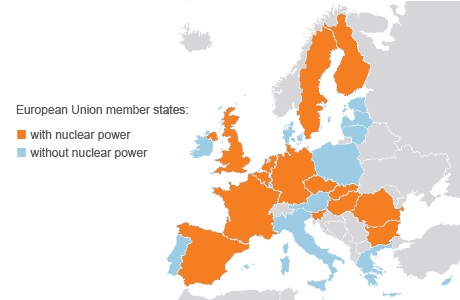A project backed by 43 organisations is preparing Europe to react and communicate effectively in case of a nuclear emergency, drawing on the lessons of the Fukushima accident.
The project, known as PREPARE, brings together national nuclear emergency centres, universities and safety authorities from 20 European countries, including Germany, Italy, Belgium, Norway and Ukraine and has €4 million ($5.4 million) in funding from the EU Framework Program for Research (FP7).
 |
| Fourteen of the European Union's 28 member states use nuclear power, as do non-EU neighbours Russia, Switzerland and Ukraine. The entire continent as far east as the Ural mountains includes 50 countries and a total of 179 nuclear power reactors |
Project work - expected to be finalised in early 2016 - will focus on what to do in case of long-lasting radiation releases, as seen during the Fukushima accident. Researchers will develop a system to collect and exchange information quickly and reliably during a rapidly-evolving emergency situation, and develop procedures and policies for dealing with potentially contaminated goods. Employees of nuclear emergency centres, safety authorities, agriculture ministries will be trained to use the tools and methods resulting from PREPARE.
"Before Fukushima, emergency plans were designed in general for releases of a few days, but at Fukushima we saw releases for up to one month and then also smaller releases," said Johan Camps, head of the Crisis Management and Decision unit at the Belgian Nuclear Research Centre told World Nuclear News.
One PREPARE tool will be used to evaluate an accident in its entirety, according to the project coordinator Wolfgang Raskob, of the Karlsruhe Institute for Technology in Germany. "We are planning to set up a database with historic events and calculation scenarios and then compare the incoming information with the information in the database."
Actions on food and other consumer goods coming from an area affected by a nuclear emergency have previously been inconsistent across Europe. Taking the example of Fukushima, Raskob noted that each European country had different rules and limits. One of the aims of the project is to recommend a procedure to set contamination limits to be used at European level when dealing with goods coming from the affected area, he explained.
Improvements to the monitoring of terrestrial and aquatic systems following a nuclear accident are also envisaged, as are better plans for informing the public during an emergency.
Media angle
"We took Fukushima as a case study and looked at how it was communicated among the experts, but also from the experts to the public and to how the media reported it," Tanja Perko, researcher at the Belgian Nuclear Research Centre, told WNN.
Perko noted big differences between European countries in the way the media reported about Fukushima. Some media focused on the safety of their own nuclear plants, others dealt with the issue of incoming contaminated goods, while some reported mainly on the developments in Japan. "We saw the word 'referendum' in more than 60% of the media articles we analysed from Italy," Perko explained, pointing out the potentially powerful link between media coverage and political events.
By Carmen Paun
for World Nuclear News






_53514_33880.jpg)






